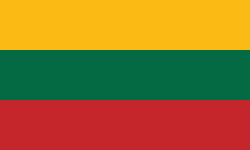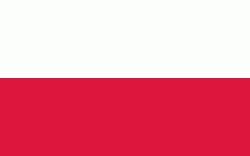Polish language
Polish (Polish: język polski,, polszczyzna or simply polski, ) is a West Slavic language of the Lechitic group written in the Latin script. It is spoken primarily in Poland and serves as the native language of the Poles. In addition to being the official language of Poland, it is also used by the Polish diaspora. There are over 50 million Polish speakers around the world. It ranks as the sixth most-spoken among languages of the European Union. Polish is subdivided into regional dialects and maintains strict T–V distinction pronouns, honorifics, and various forms of formalities when addressing individuals.
The traditional 32-letter Polish alphabet has nine additions (ą, ć, ę, ł, ń, ó, ś, ź, ż) to the letters of the basic 26-letter Latin alphabet, while removing three (x, q, v). Those three letters are at times included in an extended 35-letter alphabet, although they are not used in native words. The traditional set comprises 23 consonants and 9 written vowels, including two nasal vowels (ę, ą) defined by a reversed diacritic hook called an ogonek. Polish is a synthetic and fusional language which has seven grammatical cases. It is one of very few languages in the world possessing continuous penultimate stress (with only a few exceptions) and the only in its group having an abundance of palatal consonants. Contemporary Polish developed in the 1700s as the successor to the medieval Old Polish (10th–16th centuries) and Middle Polish (16th–18th centuries).
Among the major languages, it is most closely related to Slovak and Czech but differs in terms of pronunciation and general grammar. In addition, Polish was profoundly influenced by Latin and other Romance languages like Italian and French as well as Germanic languages (most notably German), which contributed to a large number of loanwords and similar grammatical structures. Extensive usage of nonstandard dialects has also shaped the standard language; considerable colloquialisms and expressions were directly borrowed from German or Yiddish and subsequently adopted into the vernacular of Polish which is in everyday use.
Historically, Polish was a lingua franca, important both diplomatically and academically in Central and part of Eastern Europe. Today, Polish is spoken by approximately 38 million people as their first language in Poland. It is also spoken as a second language in eastern Germany, northern Czech Republic and Slovakia, western parts of Belarus and Ukraine as well as in southeast Lithuania and Latvia. Because of the emigration from Poland during different time periods, most notably after World War II, millions of Polish speakers can also be found in countries such as Canada, Argentina, Brazil, Israel, Australia, the United Kingdom and the United States.
Polish began to emerge as a distinct language around the 10th century, the process largely triggered by the establishment and development of the Polish state. Mieszko I, ruler of the Polans tribe from the Greater Poland region, united a few culturally and linguistically related tribes from the basins of the Vistula and Oder before eventually accepting baptism in 966. With Christianity, Poland also adopted the Latin alphabet, which made it possible to write down Polish, which until then had existed only as a spoken language.
The precursor to modern Polish is the Old Polish language. Ultimately, Polish descends from the unattested Proto-Slavic language. Polish was a lingua franca from 1500 to 1700 in Central and parts of Eastern Europe, because of the political, cultural, scientific and military influence of the former Polish–Lithuanian Commonwealth.
The Book of Henryków (Polish: Księga henrykowska, Liber fundationis claustri Sanctae Mariae Virginis in Heinrichau), contains the earliest known sentence written in the Polish language: Day, ut ia pobrusa, a ti poziwai (in modern orthography: Daj, uć ja pobrusza, a ti pocziwaj; the corresponding sentence in modern Polish: Daj, niech ja pomielę, a ty odpoczywaj or Pozwól, że ja będę mełł, a ty odpocznij; and in English: Come, let me grind, and you take a rest), written around 1270.
The medieval recorder of this phrase, the Cistercian monk Peter of the Henryków monastery, noted that "Hoc est in polonico" ("This is in Polish").
The traditional 32-letter Polish alphabet has nine additions (ą, ć, ę, ł, ń, ó, ś, ź, ż) to the letters of the basic 26-letter Latin alphabet, while removing three (x, q, v). Those three letters are at times included in an extended 35-letter alphabet, although they are not used in native words. The traditional set comprises 23 consonants and 9 written vowels, including two nasal vowels (ę, ą) defined by a reversed diacritic hook called an ogonek. Polish is a synthetic and fusional language which has seven grammatical cases. It is one of very few languages in the world possessing continuous penultimate stress (with only a few exceptions) and the only in its group having an abundance of palatal consonants. Contemporary Polish developed in the 1700s as the successor to the medieval Old Polish (10th–16th centuries) and Middle Polish (16th–18th centuries).
Among the major languages, it is most closely related to Slovak and Czech but differs in terms of pronunciation and general grammar. In addition, Polish was profoundly influenced by Latin and other Romance languages like Italian and French as well as Germanic languages (most notably German), which contributed to a large number of loanwords and similar grammatical structures. Extensive usage of nonstandard dialects has also shaped the standard language; considerable colloquialisms and expressions were directly borrowed from German or Yiddish and subsequently adopted into the vernacular of Polish which is in everyday use.
Historically, Polish was a lingua franca, important both diplomatically and academically in Central and part of Eastern Europe. Today, Polish is spoken by approximately 38 million people as their first language in Poland. It is also spoken as a second language in eastern Germany, northern Czech Republic and Slovakia, western parts of Belarus and Ukraine as well as in southeast Lithuania and Latvia. Because of the emigration from Poland during different time periods, most notably after World War II, millions of Polish speakers can also be found in countries such as Canada, Argentina, Brazil, Israel, Australia, the United Kingdom and the United States.
Polish began to emerge as a distinct language around the 10th century, the process largely triggered by the establishment and development of the Polish state. Mieszko I, ruler of the Polans tribe from the Greater Poland region, united a few culturally and linguistically related tribes from the basins of the Vistula and Oder before eventually accepting baptism in 966. With Christianity, Poland also adopted the Latin alphabet, which made it possible to write down Polish, which until then had existed only as a spoken language.
The precursor to modern Polish is the Old Polish language. Ultimately, Polish descends from the unattested Proto-Slavic language. Polish was a lingua franca from 1500 to 1700 in Central and parts of Eastern Europe, because of the political, cultural, scientific and military influence of the former Polish–Lithuanian Commonwealth.
The Book of Henryków (Polish: Księga henrykowska, Liber fundationis claustri Sanctae Mariae Virginis in Heinrichau), contains the earliest known sentence written in the Polish language: Day, ut ia pobrusa, a ti poziwai (in modern orthography: Daj, uć ja pobrusza, a ti pocziwaj; the corresponding sentence in modern Polish: Daj, niech ja pomielę, a ty odpoczywaj or Pozwól, że ja będę mełł, a ty odpocznij; and in English: Come, let me grind, and you take a rest), written around 1270.
The medieval recorder of this phrase, the Cistercian monk Peter of the Henryków monastery, noted that "Hoc est in polonico" ("This is in Polish").
Country
-
Lithuanian Soviet Socialist Republic
The Lithuanian Soviet Socialist Republic (LSSR) was a short-lived Soviet Puppet state during early Interwar period. It was declared on 16 December 1918 by a provisional revolutionary government led by Vincas Mickevičius-Kapsukas. It ceased to exist on 27 February 1919, when it was merged with the Socialist Soviet Republic of Byelorussia to form the Lithuanian–Byelorussian Soviet Socialist Republic (Litbel). While efforts were made to represent the LSSR as a product of a socialist revolution supported by local residents, it was largely a Moscow-orchestrated entity created to justify the Lithuanian–Soviet War. As a Soviet historian described it as: "The fact that the Government of Soviet Russia recognized a young Soviet Lithuanian Republic unmasked the lie of the USA and British imperialists that Soviet Russia allegedly sought rapacious aims with regard to the Baltic countries." Lithuanians generally did not support Soviet causes and rallied for their own national state, declared independent on 16 February 1918 by the Council of Lithuania.
Germany had lost World War I and signed the Compiègne Armistice on 11 November 1918. Its military forces then started retreating from the former Ober Ost territories. Two days later, the government of the Soviet Russia renounced the Treaty of Brest-Litovsk, which had assured Lithuania's independence. Soviet forces then launched a westward offensive against Estonia, Latvia, Lithuania, Poland and Ukraine in an effort to spread the global proletarian revolution and replace national independence movements with Soviet republics. Their forces followed retreating German troops and reached Lithuania by the end of December 1918. -
Poland
Poland, officially the Republic of Poland, is a country in Central Europe. It is divided into 16 administrative provinces called voivodeships, covering an area of 312696 km2. Poland has a population of 37.7 million and is the fifth-most populous member state of the European Union. Warsaw is the nation's capital and largest metropolis. Other major cities include Kraków, Wrocław, Łódź, Poznań, Gdańsk, and Szczecin.
Poland has a temperate transitional climate and its territory traverses the Central European Plain, extending from Baltic Sea in the north to Sudeten and Carpathian Mountains in the south. The longest Polish river is the Vistula, and Poland's highest point is Mount Rysy, situated in the Tatra mountain range of the Carpathians. The country is bordered by Lithuania and Russia to the northeast, Belarus and Ukraine to the east, Slovakia and the Czech Republic to the south, and Germany to the west. It also shares maritime boundaries with Denmark and Sweden. -
Ukraine
Ukraine (Україна, ) is a country in Eastern Europe. It is the second-largest European country after Russia, which it borders to the east and northeast. Ukraine covers approximately 600000 km2. Prior to the ongoing Russian invasion, it was the eighth-most populous country in Europe, with a population of around 41 million people. It is also bordered by Belarus to the north; by Poland, Slovakia, and Hungary to the west; and by Romania and Moldova to the southwest; with a coastline along the Black Sea and the Sea of Azov to the south and southeast. Kyiv is the nation's capital and largest city. Ukraine's state language is Ukrainian; Russian is also widely spoken, especially in the east and south.
During the Middle Ages, Ukraine was the site of early Slavic expansion and the area later became a key centre of East Slavic culture under the state of Kievan Rus', which emerged in the 9th century. The state eventually disintegrated into rival regional powers and was ultimately destroyed by the Mongol invasions of the 13th century. The area was then contested, divided, and ruled by a variety of external powers for the next 600 years, including the Polish–Lithuanian Commonwealth, the Austrian Empire, the Ottoman Empire, and the Tsardom of Russia. The Cossack Hetmanate emerged in central Ukraine in the 17th century, but was partitioned between Russia and Poland, and ultimately absorbed by the Russian Empire. Ukrainian nationalism developed, and following the Russian Revolution in 1917, the short-lived Ukrainian People's Republic was formed. The Bolsheviks consolidated control over much of the former empire and established the Ukrainian Soviet Socialist Republic, which became a constituent republic of the Soviet Union when it was formed in 1922. In the early 1930s, millions of Ukrainians died in the Holodomor, a man-made famine. During World War II, Ukraine was devastated by the German occupation.
